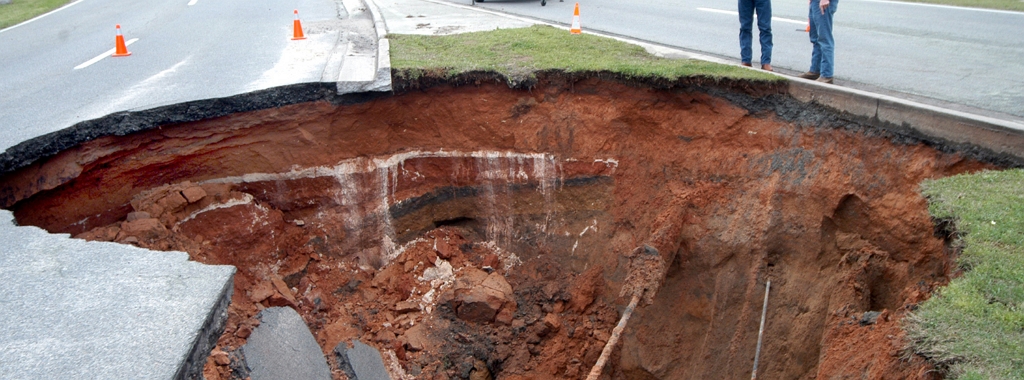Description
Karst
Karst is the term used to refer to landscapes dominated by limestone and similar soluble carbonate rocks. Acidic groundwater and rainfall dissolves the surrounding carbonate rocks creating sinkholes. Sinkholes are classified as natural depressions of the land surface. Areas with large amounts of karst are characterized by the presence of sinkholes, sinking streams, springs, caves, and solution valleys. Human activities can expedite cavity formation in these susceptible materials and trigger their collapse, as well as the collapse of pre-existing subsurface cavities. Sinkholes are a frequent occurrence in areas underlain by calcareous carbonate formations, especially limestone and dolomite. Areas of abundant sinkholes are referred to as karst topography.
Land subsidence
Land subsidence is the lowering of surface elevations due to changes made underground. It involves either the sudden collapse of the ground to form a depression or the slow subsidence or compaction of the sediments near the Earth's surface. It often occurs in regions with mildly acidic groundwater and the geology is dominated by limestone, dolostone, marble, or gypsum. Land subsidence is often due to natural processes: the dissolution of carbonate rocks (limestones) beneath the surface. In addition, human activity such as fluid withdrawal (e.g. pumping of water, oil, or gas) from underground reservoirs can cause land subsidence. Because the fluid withdrawal related subsidence usually destroys small areas, this plan update focuses on the carbonate substances related land subsidence which usually impacts massive areas.
Karst Aquifers
An aquifer is a subsurface layer or zone of porous and permeable rock, or porous and permeable unconsolidated sediments (e.g., sand or gravel) that has groundwater in its openings. Water in karst regions typically moves from sinkholes--where it is diverted from surface to subsurface pathways--to subterranean passages, and back to surface water at the spring outlet. Aquifers in karst regions can hold tremendous quantities of water because of the very large size of the openings that are commonly present in the limestone (e.g. cave passageways that are completely flooded with water). (Source: https://www.dcr.virginia.gov/natural-heritage/vcbsinkholes )
Location and Extent
The distribution of mature surface karst landscapes are primarily dependent on the presence of soluble rocks at or near the land surface and mean annual precipitation above approximately 30 inches. In the United States, the formation of underground cavities can form and catastrophic sinkholes can occur. These rock types are evaporites (salt, gypsum, and anhydrite) and carbonates (limestone and dolomite). In the Eastern U.S., most karst features such as sinkholes occur in carbonate (limestone and dolomite) rocks.
The most dominant karst region in Virginia is the Valley and Ridge Province in the western third of the state. Smaller karst areas also occur in the Piedmont, Cumberland Plateau, and Coastal Plain provinces. Although the karst landscape is not prevalent in the Piedmont region where the CVPDC is located, The western edge of the region is immediately adjacent to the edge of the Valley and Ridge Province. Soluble carbonate rock units susceptible to karst development include primarily limestone and dolomites, which are chiefly distributed throughout the Valley and Ridge Province. Smaller carbonate areas, consisting of limestone, dolomite, and marble, occur in the Piedmont region as well, primarily along the northern boundary of Appomattox County and Campbell County.
History
According to the Virginia State Hazard Mitigation Plan, there have been no Federal Declared Disasters or National Centers for Environmental Information (NCEI) recorded events for karst related events either in the CVPDC area or in the Commonwealth. Land subsidence and sinkholes are very site-specific. There is no comprehensive long-term record of past events in Virginia.
Plan Chapter
CVPDC HMP 2020





